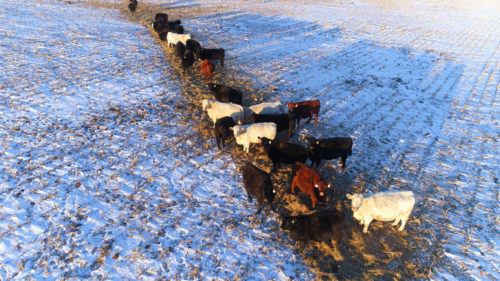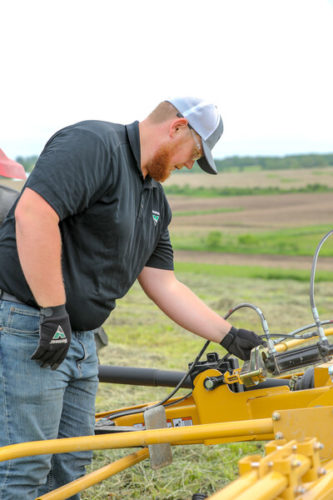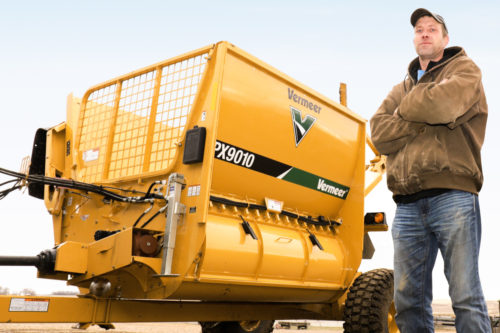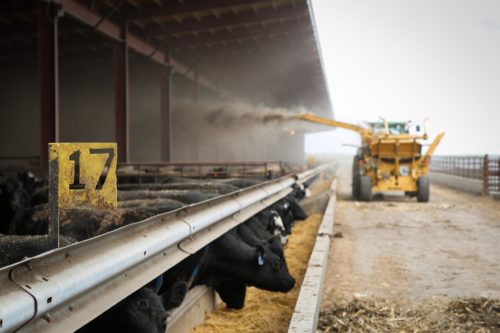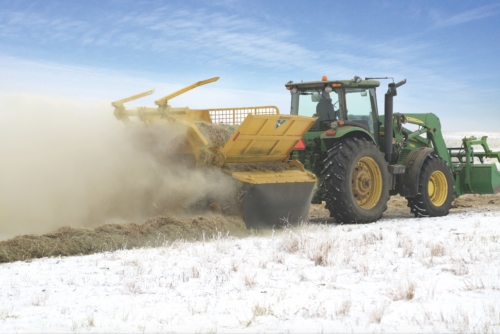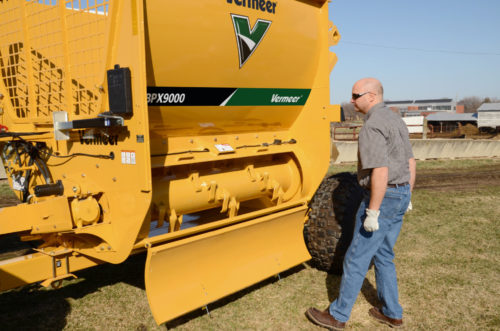
Feed and Bed Your Cows Without All the Waste
March 2022
During the winter, a pregnant 1200-lb beef cow typically consumes 2 percent of her body weight every day to feed herself and grow her calf. That’s 26 pounds a day on an “as fed basis” – every day.* How does that project over a 50-cow herd operation? That’s 1300 pounds of forage fed daily or 97.5 tons during a 150-day timeframe. Total projected cost at $60/ton?**$5,850.
What’s missing in this equation?
The waste. Depending on your harvesting, storage and feeding techniques, as much as 40 to 50 percent of the nutrients in your round bales could be wasted.*** Using the example above, that amounts to 65 – 97.5 tons of additional forage for every 97.5 tons your cows actually consume. At that rate, you and your cows could potentially blow through another $3,900 to $5,850 in forage costs.
If feed represents the largest single cost – up to 60 percent of your total cost – in a cow-calf enterprise, how much hay are you and your cows using each day during the feeding season? And how much is actually being consumed? Perhaps it’s time to re-evaluate the waste and efficiencies of your bale feeding system. Here are a few ways to reduce hay waste, improve your operating efficiencies and likely save money.
It starts when you’re harvesting.
Make sure you bale grasses and legumes when crude protein (CP) and total digestible nutrients (TDN) are at their peak levels.
According to University of Missouri forage specialist Robert Kallenbach, peak quality fescue/clover hay may have CP of 18 percent and TDN in the 60th percentile. If harvest of fescue/clover hay is delayed until seed heads mature, CP may drop to 7 percent and TDN may fall into the low 5th percentile. As a result, cows may need added supplements to maintain body condition.
A recent study by North Dakota State University estimates dry matter losses for hay average 28 percent – and range from 5 to 61 percent – depending on how hay is stored. Covering round bales stored outside reduced dry matter losses to 13 percent, and losses were just 5 percent on bales stored inside.
Thus, a barn is your first choice, although it’s not always economically practical. Hay sheds are a good alternative, because you can build up the floor with gravel for good drainage, keeping the entire haystack dry.
Don’t have a barn or any type of structure to shelter your hay? Create a well-drained area using gravel or wooden pallets. Then, stack the bales strategically to allow water to be diverted away from the storage area by covering the bales with tarps.
Planning to build storage areas or purchase hay covers? Iowa State University Extension offers a hay storage cost comparison tool to help you evaluate the economics of your purchase.
Another study conducted by the University of Tennessee reported the following results using different storage methods:
- Stored on the ground; no cover — 37% loss
- Stored on the ground; cvered — 29% loss
- Stored on tires; no cover — 29% loss
- Stored on tires; covered — 8% loss
- Netwrapped; stored on ground; no cover — 19% loss
- Stored in the barn — 6% loss
Process your bales
Looking to increase the efficiency in your feeding operation? Many cow-calf producers are now using bale processors in their feeding/bedding operations simply because it allows them to maximize hay supplies, reduce labor, provide herds with a cleaner and healthier open-range feeding environment and eliminate a lot of the manure handling issues they’ve had in the past with bale rings.
If you process hay on a daily basis (even if you are processing into a windrow in open range on the ground), you can effectively limit intake and reduce hay losses. At the same time, all your cows get an equal opportunity at feeding time, because they have greater access compared to feeding with bale rings. Processors also improve the palatability of bales by eliminating a lot of dust, mold and mildew, so there’s less stress and risk from contaminants and less sorting by cows.
The benefits of using a bale processor also go well beyond hay savings.
According to the University of Missouri Extension Service, for every 900-lb bale fed in your pasture, your cows will return $20 to $30 in nutrients to the soil in the form of fertilizer. Project that return out, based on a herd of 50 cows during a 150-day winter feeding period. It means you can recycle roughly $2,000 worth of fertilizer nutrients (manure) through cows fed on grass hay. And if it’s practical for your operation, you can spread the feeding zones more evenly throughout your pastures.
Bale processors also provide you with a faster, more robust and more effective way to lay down a thick, uniform mat of hay or cornstalks for winter bedding. Owning one allows you to process and mix your own feed based on your schedule, without depending on outside suppliers. From a time and labor saving perspective, that is likely a huge benefit.
Bale processors with multiple cutting stages – such as the Final Cut™ FPX9000 bale processor from Vermeer – can reduce the size of processed hay down to an average cut length of 1-1/4″ to 4″. This creates the optimum material size for digestibility and efficiency in the cow’s rumen and it enables you to produce a piece of your total mixed ration feed, or process hay into feed bunks along with other grains or supplements.
Bale processors are also instrumental for bedding cattle in various applications. For example, the Vermeer Catapult® CPX9000 bale processor can process either round or square bales and accurately shoot hay or straw material 60 to 100 feet (18 to 30 m) and create a smooth, consistent layer of bedding in a monoslope building or feedlot.
When selecting a bale processor for your operation, be sure it provides the versatility you’re looking for – the ability to process everything from high moisture silage to cornstalks, including round bales or square bales; the flexibility to perform in all types of situations, from laying down windrows and bunk feeding to blowing bedding into shelters or forage into storage bunkers; and right-sizing hay material for total mixed rations.
Manage your feeding environment
When cows are fed a limited amount of hay on a daily basis (or even on an every-other-day basis), you can process your bales into neatly formed windrows on frozen ground because the cattle will be less inclined to trample, soil and waste the hay.
Feed bales that have been stored outside first, then feed those that have been stored inside. Why? Because cattle fed higher-quality hay early in the season will often refuse poor-quality hay later on.
Feed hay in well-drained areas. If you intend to feed hay in a single location all winter, do it on crushed gravel or concrete to help minimize the mud and manure and to prevent contamination of the cows’ udders and safeguard the health of the nursing calves. Another option is to move hay-feeding areas.
Find out which bale processor is right for you.
*Research conducted by Dr. Glenn Selk, Emeritus Extension Animal Scientist at Oklahoma State Extension. Twenty-six pound/day consumption rate is based on the following assumption: (1) Feeding grass hay that is quality-rated as “good”. (2) Averaging 92 percent dry matter, 8 percent moisture content and achieving a crude protein rating of 8 percent.”
**$60 cost per ton is used strictly for illustrative purposes; hay prices vary regionally based on quality, supply and other factors.
***University of Missouri Extension Service Findings: Reducing Losses When Feeding Hay to Beef Cattle by Robert Kallenbach, Department of Agronomy.


